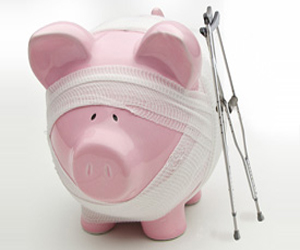Send this article to a friend:
March
29
2025
Send this article to a friend: March |
Fed Chair Admits He's Powerless to Stop Stagflation Threat
Ever since Paul Volcker took the helm at the Federal Reserve back in 1979 and ended the decade of stagflation, the Federal Reserve has played a key role influencing the American economy. We won’t be discussing whether or not that’s beneficial – not today. It’s simply a fact that modern nations who manage their own currencies have a central bank. The Federal Reserve’s mandate is “promoting maximum employment, stable prices, and moderate long-term interest rates.” Primarily, they do so by managing both the money supply and interest rates. With that in mind, let’s discuss the recent FOMC meeting. What did the Federal Reserve do this week?Actually, we need to talk about what the Fed didn’t do this week, and it has many people concerned. A summary from Axios tells us:
That’s right, the Fed kept interest rates the same. Now, technically, the Fed does most of its work with a single interest rate – the Effective Federal Funds Rate. That’s the rate at which commercial banks borrow and lend excess reserves to each other overnight. It’s also the benchmark used to determine rates on everything from savings account yields to the APR on your credit card. When that rate goes down, banks don’t want to hold reserves – they want to lend instead. Borrowing becomes easier (and cheaper), economic activity increases and so on. When that rate goes up, banks prefer not to make loans, simply because they can make a profit on their excess reserves. Borrowing becomes harder and more expensive, credit-dependent economic activity slows – you get the idea. Lower interest rates cause the economy to grow. Interest rates that are too low cause the economy to grow in unhealthy ways, also known as malinvestment. When the economy grows too fast, in unhealthy ways, we say the economy is overheating. Prices go up and families struggle with the cost of living. Higher interest rates discourage borrowing and speculative ventures. They also discourage consumption – when families can save money and watch it grow, replacing the flat-screen TV with a newer, bigger model doesn’t seem quite as urgent. With all that in the background, you may be wondering why the Fed chose to keep interest rates unchanged:
What specifically were they concerned about? Here’s a list:
That list is more or less a confession that the Federal Reserve just isn’t sure how the U.S. economy will respond to the Trump administration’s policies. Fed chair Jerome Powell says that he thinks that Trump’s policies will cause prices to rise. Jacob Burg with The Epoch Times writes:
We all know that tariffs will make prices go up. That’s how tariffs work. The bigger news, though, is in the changes to the Fed’s long-term economic forecast… Stagflation warningAlthough Jerome Powell didn’t say “stagflation” – he didn’t even say the R word, “recession,” during the Wednesday FOMC press conference – he didn’t have to. The Fed’s “summary of economic projections” did the talking for him…
That’s a bundle of bad news. In fact, Goldman Sachs chief operating officer John Waldron warned of a stagflation scenario – one where sticky inflation eats away at economic growth (and our savings), where unemployment is high and the Fed’s hands are tied. Stagflation is particularly concerning to the Fed because it leaves them stuck between the proverbial rock and the hard place:
Now, some observers will give the Fed credit for being concerned about Trump’s policies and their unpredictable effects. That’s fair. On the other hand, if they’re really concerned about that stubborn inflation well above their target, why aren’t they taking action? At the same time, their own economic forecasts predict at-best stunted growth for the next two and a half years. It seems to me like the Fed is admitting stagflation has already arrived – they just didn’t say it out loud… So, what should we do about the stagflation threat?Answer: You can choose to insulate your personal finances from broader economic threats. How? By diversifying into inflation-resistant stores of purchasing power. When you do that, you will create a foundation for you and your family that you can build upon to reach your financial goals and to provide security regardless of what is happening to the rest of the world. And what is the best inflation-resistant store of purchasing power to invest in? In my opinion, it is clearly precious metals which have a long history of maintaining purchasing power regardless of currency devaluation. Stagflation, for example. Should the economic situation continue to develop as the Fed fears, we can look to history. Fortunately, this is a rare climate... The last time the U.S. experienced inflation, during the "lost decade" of 1971-1980, the dollar's purchasing power declined by 54%. Home prices tripled, business investment sagged, unemployment hit double digits (and so did inflation). The gold price, on the other hand, rose 2,300% from $35 to $850 per ounce. A smart place to start your research in order to do your due diligence is by finding out more about precious metals IRAs.
|
Send this article to a friend:
 |
 |
 |